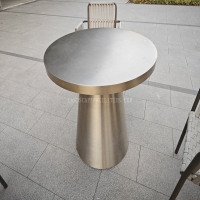Welcome to the website for landscape facilities products and knowledge.
What are the key considerations for using the Landscape Round Table in community or shared spaces?
Integrating Landscape Round Tables into community and shared spaces requires thoughtful planning to maximize their potential for social interaction and aesthetic appeal. The circular design naturally promotes inclusive conversations by eliminating hierarchical seating positions, making them ideal for fostering community engagement in public parks, corporate campuses, and residential complexes.
Primary considerations begin with strategic placement. These tables should be positioned in areas with natural foot traffic while maintaining appropriate clearance for accessibility. The location should balance sunlight exposure with available shade, particularly in warmer climates, to ensure comfortable usage throughout different times of day.
Material selection proves crucial for longevity and maintenance. Weather-resistant options like powder-coated aluminum, marine-grade polymer, or sustainably sourced hardwoods withstand environmental elements while reducing upkeep costs. The surface finish should resist graffiti, stains, and UV damage to maintain visual appeal with minimal intervention.
Understanding user demographics informs appropriate sizing and configuration. For family-oriented spaces, consider integrating complementary seating like accompanying benches or movable chairs. In formal settings, fixed seating might better serve security and maintenance needs. The table height should accommodate both casual dining and work purposes, typically between 28-30 inches for standard use.
Accessibility remains non-negotiable in public installations. Ensure ADA compliance by providing clear knee space underneath, maintaining proper approach distances, and considering tactile elements for visually impaired users. Many designers incorporate contrasting colors between seating and table surfaces to aid navigation.
The surrounding landscape should complement rather than compete with the installation. Incorporate soft landscaping like ornamental grasses or low shrubs to create natural boundaries without obstructing sightlines. Lighting integration extends usability into evening hours while enhancing security through well-placed, glare-free fixtures.
Successful implementations balance aesthetic harmony with functional durability. The table design should reflect the architectural character of its surroundings while providing practical benefits like integrated charging ports, center planters, or customizable surface treatments that reflect community identity.
Maintenance planning from the outset prevents future complications. Specify materials that resist common issues like moisture damage, insect infestation, or thermal expansion. Establish clear protocols for regular cleaning, inspection, and repairs to preserve both safety and visual quality over decades of use.
Ultimately, Landscape Round Tables serve as social catalysts when properly implemented. Their configuration encourages spontaneous interactions while providing comfortable spaces for planned gatherings. By addressing these considerations during the planning phase, communities can create vibrant, inclusive outdoor environments that strengthen social bonds and enhance quality of shared spaces.
Related search:

Recommendation
Outdoor Metal Table - Classic Outdoor Furniture, Stainless Steel Table, Durable and Reliable